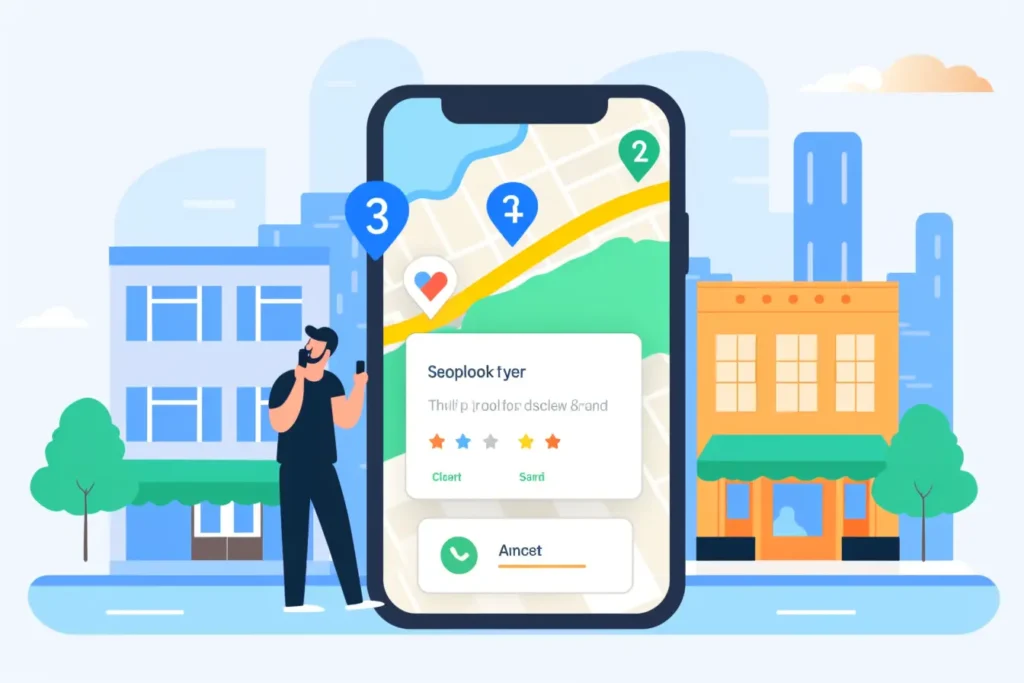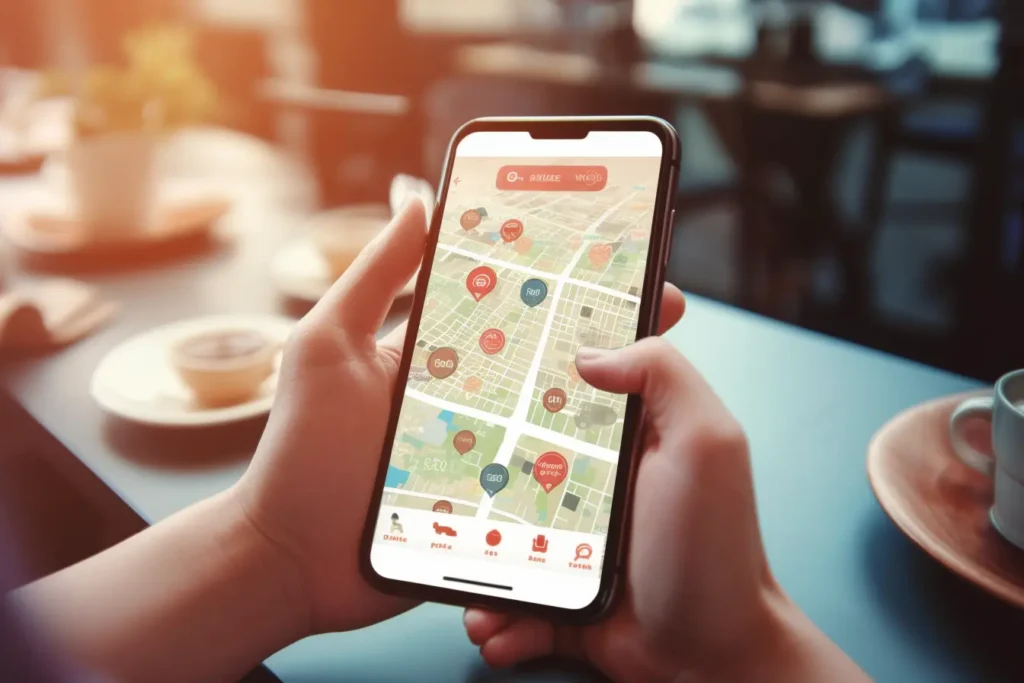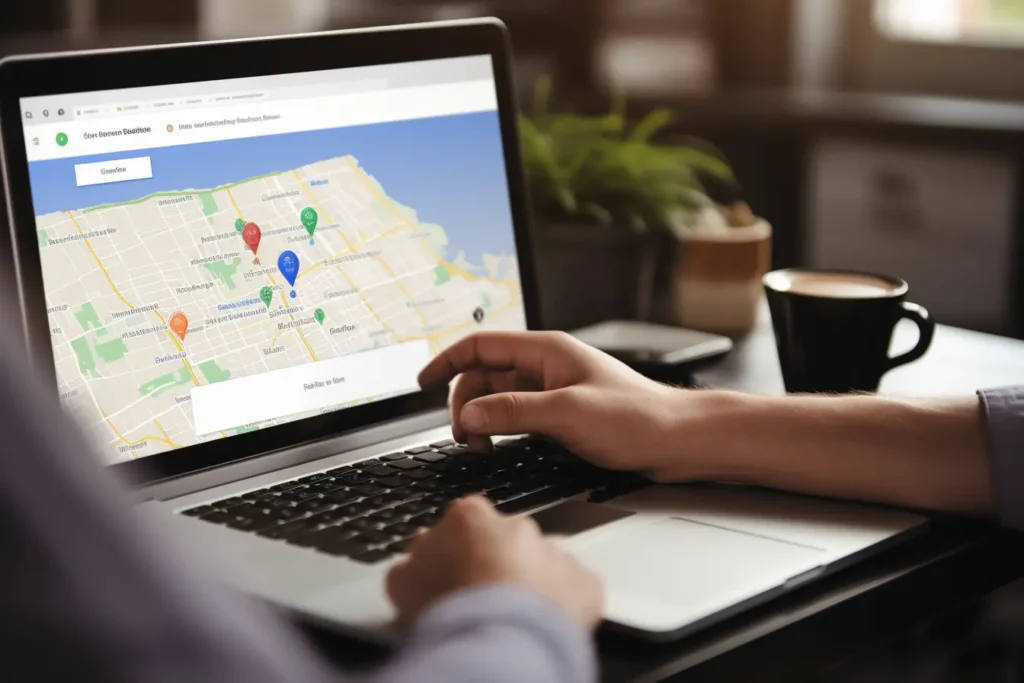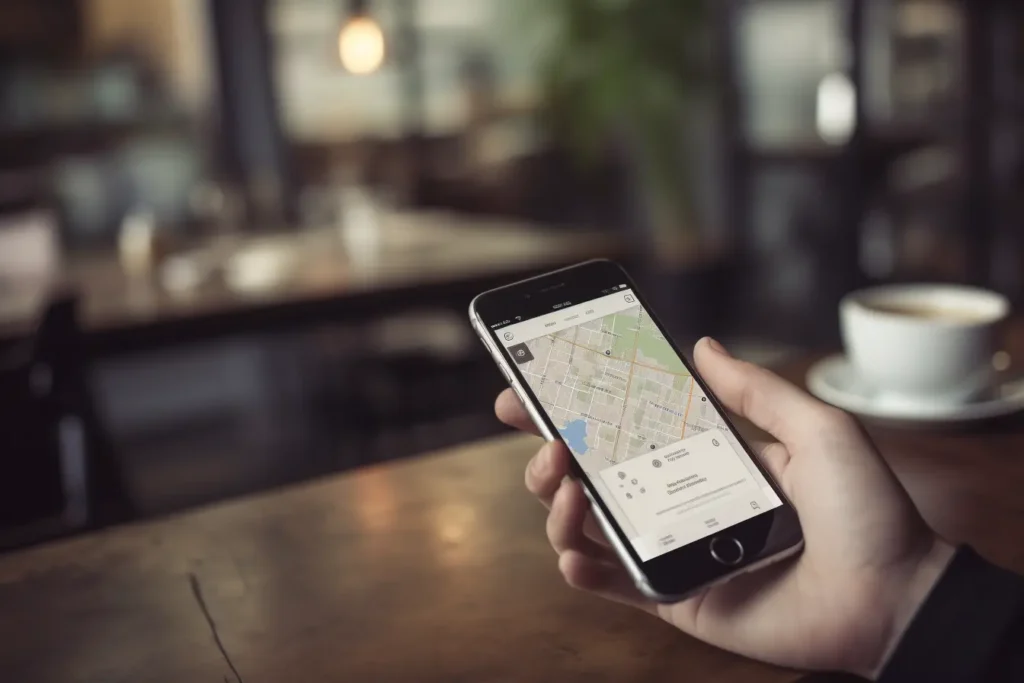Hey there, small business owner! Are you looking to improve your online presence and attract more local customers? Well, you’re in luck because we’ve got the ultimate guide to local SEO just for you. With 46% of Google searches being for local information, optimizing your online presence for local search can help you reach potential consumers who are actively searching for products or services in their area.
But before we dive in, let’s get one thing straight – local SEO isn’t rocket science. It’s all about making sure your business appears when people search for it locally. And trust us, with the right tools and strategies at your disposal, it’s easier than ever to improve your online visibility and attract more local customers. So buckle up, put on your thinking cap (or beret if that’s more your style), and get ready to learn everything you need to know about dominating the world of local search.
Overview

If you’re a small business owner looking to improve your online visibility and attract more local customers, this section is a must-read. In this local SEO guide, we’ll walk you through the basics of search engine optimization for local search. By optimizing your business profile for local search, you can increase your chances of showing up in relevant search results when potential customers are looking for products or services like yours in their area.
So what exactly is local SEO? It’s the process of optimizing your online presence to improve visibility in Google’s local search results. This includes optimizing your website, business listings on directories and maps, and social media profiles to ensure that they show up in relevant searches for users who are located near your physical location(s). The goal is to make it easy for potential customers to find and connect with your business when they’re searching locally.
By implementing effective local SEO strategies, businesses can reap numerous benefits such as higher website traffic, increased foot traffic to brick-and-mortar locations, improved brand awareness and reputation management among locals, and ultimately greater sales conversions. So let’s dive into some key signals and benefits of effective local SEO without further ado!
Signals and Benefits

Understanding the signals and benefits of optimizing for local search can help you improve your online visibility, attract more customers in your area, and ultimately drive revenue growth for your business. By focusing on local search engine optimization (SEO), you can send signals to search engines that will make it easier for potential customers to find you when they’re searching online. These signals include things like consistent NAP information (name, address, phone number), local content on your website and social media pages, and high-quality inbound links from other authoritative websites.
The benefits of investing in local SEO are clear: increased visibility in search results means more traffic to your website, which in turn leads to more leads and sales. Local SEO is especially important for businesses with brick-and-mortar locations who want to attract nearby customers searching for products or services like theirs. By optimizing their online presence with accurate business information and localized content, these businesses can differentiate themselves from competitors who are not taking advantage of this powerful marketing channel.
In short, if you’re not already paying attention to local SEO as part of your overall digital strategy, you’re missing out on a huge opportunity to grow your business. The good news is that there are plenty of resources available – including this Local SEO Guide – that can help you get started. Up next: a look at one of the most important tools in the local SEO toolbox – Google My Business!
Google My Business

Now it’s time to dive into the benefits of using Google My Business, a valuable tool that can help you put your business on the map and give it a leg up against the competition. As we’ve previously discussed in this local SEO guide, optimizing for local search engine results is crucial for small businesses. And with its ability to show up at the top of search engine results pages, Google My Business can be a game-changer.
By creating and verifying your business on Google My Business, you’ll increase your chances of appearing in local search queries relevant to your industry. Not only does this boost your online visibility, but it also helps potential customers find useful information about your business such as reviews, hours of operation, location details and more. Plus, by utilizing features like Google Posts and encouraging customers to leave reviews online, you can further improve your online reputation and attract more traffic to your website.
Incorporating Google My Business into your overall SEO strategy guide is essential if you want to succeed in today’s digital landscape. With its ability to showcase important information about your business directly on top of search engine results pages, it’s no wonder why so many small businesses are taking advantage of this free tool. So what are you waiting for? Sign up today and take control of how potential customers perceive your brand! Now let’s move onto our next topic: social media engagement.
Social Media Engagement

Let’s explore the importance of social media engagement in boosting your business’s online presence and attracting more customers. Social media is a powerful tool for businesses to increase their visibility, drive traffic to their website, and improve their local SEO. By regularly posting engaging content on social media platforms such as Facebook, Twitter, and Instagram, you can attract potential customers to your business profile.
Social media engagement also plays a key role in building relationships with your audience. By responding promptly to comments and messages, you can establish trust with your customers and foster a sense of community around your brand. This not only helps improve your local SEO but also increases customer loyalty and word-of-mouth referrals.
To maximize the benefits of social media engagement for local SEO, make sure to optimize your profiles with accurate NAP (name, address, phone number) information and consistent branding across all platforms. This will help search engines like Google identify your business as a reputable and trustworthy source of information for local consumers.
As we’ve seen, social media engagement is an essential component of any successful local SEO strategy. However, it’s just one piece of the puzzle – next up we’ll be exploring how NAP consistency can further boost your online presence!
NAP Consistency

Ensuring consistent and accurate NAP information across all online directories is crucial for improving your business’s visibility and credibility in local search results. NAP, which stands for Name, Address, Phone number, is a foundational SEO practice that can greatly impact your local rankings. By listing the same NAP information on Google My Business, social media profiles, and other directories, you increase the likelihood of search engines recognizing your business as legitimate and trustworthy.
In fact, NAP consistency is considered one of the top ranking factors for local SEO. It not only helps with search engine recognition but also improves user experience. When potential customers are trying to find your business online or looking up information about it, seeing inconsistent or incorrect NAP information can be frustrating and lead them to look elsewhere. On the other hand, a consistent and accurate NAP profile across multiple platforms can help establish trust with customers before they even walk through your doors.
Make sure to review all of your online directories regularly to ensure they have the most up-to-date NAP information possible. This will not only improve visibility but also save you from potential headaches down the road when trying to correct inaccurate listings. As you continue following this local SEO guide towards visibility the definitive citation audit stage comes next where we’ll dive deeper into ensuring accuracy across all online platforms by auditing existing citations.
Citation Audit

Make sure your business is accurately represented online and gain credibility with potential customers by conducting a thorough citation audit using the latest tools and techniques. A citation audit involves verifying that all of your business’s information, including name, address, phone number (NAP), website URL, and other relevant details, are consistent across all online directories and citations. By doing so, you can improve your organic search ranking for local search engine results pages (SERPs) and attract more local customers.
One important aspect of a citation audit is identifying any inconsistencies or errors in your NAP information. This could include variations in the spelling or formatting of your business name, incorrect phone numbers or addresses listed on third-party directories, or missing information altogether. These discrepancies can negatively impact your local SEO efforts by confusing search engines and potential customers alike.
To conduct a comprehensive citation audit for your business, you will need to use specialized tools like Whitespark Local Citation Finder or Moz Local. These platforms can help you identify any existing citations for your business across various directories and review sites as well as highlight any incomplete or inconsistent information that needs to be updated. By optimizing these listings with accurate NAP data and relevant keywords, you can boost your visibility in local search results pages and stay ahead of the competition.
As you continue to optimize your business’s citations for maximum local SEO benefits, it’s also important to keep an eye on what competitors are doing in this space. In the next section about competitor analysis, we’ll explore how analyzing other businesses’ local SEO strategies can help inform yours moving forward without becoming too consumed by their tactics.
Competitor Analysis

Now it’s time to take a closer look at what your competitors are doing in the local search space so you can gain valuable insight and stay ahead of the game. Competitor analysis is a crucial step in any local SEO guide because it allows you to see what keywords they’re targeting, where they’re getting their backlinks from, and how they’re positioning themselves in local search results. Here are three reasons why competitor analysis is essential for businesses looking to improve their local search engine optimization:
- It helps identify gaps in your own strategy: By analyzing what your competitors are doing well, you can get an idea of where you might be falling short. For example, if one of your competitors has more reviews on Google My Business than you do, that could be an area where you need to focus your efforts.
- It provides inspiration for new ideas: Looking at what others in your industry are doing can spark new ideas for content or promotions that could help set you apart from the competition.
- It gives you a benchmark for success: By tracking your progress against that of your competitors, you’ll have a better understanding of whether or not your efforts are paying off.
When conducting competitor analysis as part of your local SEO guide, there are several tools available that can help make the process easier. Ahrefs and SEMrush are two popular options that allow you to see which keywords your competitors are ranking for and analyze their backlink profiles. BrightLocal also offers a Local Search Audit tool that provides insights into how well businesses within a particular industry or location area performing.
By taking the time to analyze what other businesses in your industry are doing with regard to local search engine optimization, you’ll be better equipped to adjust your own strategy accordingly. So don’t skip this crucial step – it could mean the difference between being on page one or page five of those all-important search results.
As we move onto website audit in our local SEO guide, keep in mind that the insights you gain from competitor analysis will be invaluable in helping you identify areas of your own website that need improvement.
Website Audit

Let’s dive into the website audit section and discover how to improve your online presence and attract more potential customers. As you know, a website audit is a crucial step in any local SEO practice. By analyzing your website, you can identify areas that need improvement and optimize them for better organic search results. Here are four key elements of a successful website audit:
| Element | Importance |
|---|---|
| Site speed | Slow loading times can hurt user experience and reduce search engine rankings. |
| Mobile-friendliness | With 61% of all Google searches performed on mobile devices, having a mobile-friendly site is essential for local SEO success. |
| Content quality | Quality content helps establish authority in your industry and attracts potential customers to your site. |
| On-page optimization | This includes optimizing title tags, headers, meta descriptions, and URLs with relevant keywords to improve search engine visibility. |
Improving these elements can have a significant impact on your local SEO strategy. By increasing site speed, ensuring mobile-friendliness, producing high-quality content, and optimizing on-page elements for relevant keywords, you can boost your online presence and attract more potential customers.
Incorporating these improvements into your website will not only benefit your local SEO strategy but also enhance the overall user experience for visitors to your site. With these changes implemented, let’s move onto the next step: internal linking strategies to distribute page authority among pages effectively without diluting it across too many pages or links.
As we continue through this ‘local seo guide’, remember that each step builds upon the last one until you have an optimized online presence that attracts potential customers from all over!
Internal Linking

The section at hand focuses on the importance of internal linking strategies to effectively distribute page authority and enhance the user experience for visitors to your site. As a local SEO guide, it’s crucial to understand the impact that internal linking has on your website’s ranking potential. By implementing proper internal linking practices, you can improve your website’s navigation, help search engines understand which pages are most important, and ultimately increase overall traffic.
To organic your local SEO practice with internal linking, consider implementing these tips:
- Use descriptive anchor text: When creating links within your website content, be sure to use descriptive anchor text that accurately describes where the link leads. This not only helps users navigate your site more easily but also provides contextual clues for search engines.
- Link from high-authority pages: Consider linking from high-authority pages (such as your homepage) to other pages on your site that may not have as much authority. This can help evenly distribute page authority throughout your site and improve rankings for all pages.
- Avoid excessive linking: While internal links are important, it’s equally important to avoid excessive linking that may come off as spammy or manipulative. Make sure each link serves a purpose and adds value for the user.
By following these tips and incorporating effective internal linking strategies into your local SEO practice, you can boost rankings and provide a better user experience for visitors to your site. Next up in our guide is URL, title, and content optimization – an essential aspect of any successful local SEO strategy.
As we move forward in this local SEO guide, remember that optimizing URL structure, title tags, headers, meta descriptions and content is just as important as implementing effective internal linking strategies. These elements work together to create a cohesive user experience while providing key information for both users and search engines alike. So let’s dive into how you can optimize these aspects of your website in order to further enhance its effectiveness in driving traffic locally!
URL, Title, and Content Optimization

Optimizing URL structure, title tags, headers, meta descriptions and content is like a symphony of elements working together to create a harmonious melody that not only attracts users but also provides key information for search engines. When it comes to local SEO guide, these elements are crucial in helping your business get found by potential customers in your area. By including high-volume keywords in your URL, title tags, headers and meta descriptions, you’re providing important signals to search engines about what your page is all about.
But it’s not just about stuffing keywords into every nook and cranny of your website. Content optimization is equally important when it comes to local SEO guide. Your website should have helpful information that appeals to both search engines and users alike. This means writing quality content that provides valuable information while still incorporating relevant keywords where appropriate.
Remember that local SEO guide isn’t just about optimizing for search engines – it’s also about creating a positive user experience for potential customers. By crafting quality content with optimized elements throughout your website, you’ll be able to attract more traffic from local searches and keep visitors engaged with your brand. And the best part? You’ll be well on your way towards establishing yourself as an authority in your industry.
With strong URL optimization, title optimization and content optimization under control, you’re ready to take the next step towards improving your local SEO guide: creating location pages. By highlighting each of your brick-and-mortar locations on their own dedicated pages within your website, you can provide even more detailed information for potential customers searching locally. So let’s dive into how creating location pages can help boost your local SEO even further!
Location Pages

Creating location pages is essential for businesses to provide detailed information about each brick-and-mortar location, enhancing the user experience and improving search engine visibility. These pages should include specific details such as the address, phone number, hours of operation, and any special promotions or events happening at that particular location. By providing this information on your website, you’re not only making it easier for potential customers to find you but also showing search engines that your business is a relevant and authoritative source for local search.
Location pages are also an integral part of your SEO strategy since they allow you to target specific geographical areas with high-volume keywords. By optimizing each page with location-specific keywords in the URL, title tags, headers, meta descriptions, and content, you can increase your chances of appearing in local search results when potential customers are searching for products or services in your area. Additionally, having multiple location pages can help distribute ranking power among different pages on your site and prevent keyword cannibalization.
When creating location pages, remember to keep them consistent with other business listings across the web. This means using the same NAP (name/address/phone number) information on every page and ensuring that all online directories have accurate information about each location. Doing so will help establish credibility and trust with both search engines and potential customers. Once you’ve created these pages, be sure to regularly update them with fresh content such as customer reviews or news related to that particular location.
Transition: Now that you have optimized your website’s location pages for maximum local SEO impact let’s move onto discussing how local content creation can further boost visibility in organic searches.
Local Content Creation

Boost your visibility in organic searches by creating content that appeals to your local audience and establishes your authority in the industry. Local content creation is an essential part of search engine optimization (SEO), as it helps businesses rank higher in local search results. Here are four tips for creating local content that resonates with your target audience:
- Show off your expertise: Share valuable insights and knowledge about your industry through blog posts, tutorials, or how-to videos.
- Highlight community involvement: Showcase your support for local events or charities to demonstrate that you’re invested in the community.
- Use location-specific keywords: Incorporate high-volume keywords related to your city or region into website SEO to increase visibility for local searches.
- Leverage user-generated content: Encourage customers to share their experiences with your business on social media and use those testimonials in future marketing efforts.
By creating engaging and informative content that speaks directly to your local audience, you can improve brand awareness, drive traffic to your website, and ultimately increase revenue. Don’t underestimate the power of a well-crafted piece of content – it can make all the difference when it comes to attracting new customers.
As important as local content creation is, it’s just one piece of the puzzle when it comes to optimizing for local search results. In our next section on Google My Business optimization, we’ll explore how this tool can help boost visibility even further by providing key information about your business directly in search results.
Google My Business Optimization

In this section, let’s dive into how optimizing your Google My Business page can boost your business’s visibility and attract more local customers. Did you know a small Seattle coffee shop saw a 30% increase in foot traffic after updating their Google My Business profile with accurate information and eye-catching photos? By optimizing for keywords relevant to your business, you can improve search engine ranking and drive more traffic to your website.
One of the most important aspects of Google My Business optimization is ensuring NAP consistency (name, address, phone number) across all online directories. This means verifying that your business information matches exactly on every platform where it appears. Additionally, regularly posting updates on Google Posts and encouraging customers to leave reviews online can also improve your local SEO. Keep in mind that high-quality content is key – so be sure to include relevant keywords in both descriptions and tags.
Remember: optimizing for local SEO isn’t a one-time task – it’s an ongoing process! Regularly monitoring performance metrics like traffic levels and conversion rates will help identify areas for improvement. In the next section, we’ll cover how social media content plays a crucial role in local SEO strategy. So don’t stop here – keep reading to learn more about how you can amplify your digital presence even further!
Social Media Content

You’ve nailed your Google My Business optimization, now it’s time to tackle social media. Don’t underestimate the power of social media content when it comes to local SEO. By using relevant keywords and engaging with your audience, you can drive traffic to your website and increase visibility for your business profile.
One way to optimize social media for local search is by incorporating keywords into your posts. Think about what people in your area might be searching for and use those terms in your captions and hashtags. Engage with local users by commenting on their posts and participating in community conversations, which can help build relationships that translate into online reviews or referrals.
Don’t forget to also leverage the potential of social media ads, which allow you to target specific demographics within a certain radius of your physical location. This can be especially beneficial if you have a new product or service that you want to promote locally. With a little creativity and effort, social media can become an invaluable tool for driving local traffic and boosting your overall SEO strategy.
Now that we’ve covered the importance of social media content for local SEO, let’s move on to another crucial element: NAP consistency. Making sure that all online directories have consistent information about your business name, address, phone number (NAP) is essential for search engines like Google to display accurate results when someone searches for you locally. So let’s dive into how you can achieve NAP consistency across all platforms…
NAP Consistency

Now it’s time to get serious about your business profile in the online world. If you want search engines to display accurate information when potential customers are looking for you locally, then NAP consistency is key. That means ensuring that your name, address, and phone number are the same across all directories and platforms.
You can use tools like Moz Local to help with this process. This will save you a lot of time and effort because Moz Local automatically updates your information across multiple directories. Plus, it helps you identify any inconsistencies so that you can fix them quickly.
Remember, NAP consistency is just one aspect of local SEO optimization. But it’s an important one! By taking care of this step, search engines will be able to show your business in their results more accurately. Next up: let’s talk about how online directories play a role in your search engine optimization strategy.
Online Directories

If you want to skyrocket your chances of getting found by potential customers, online directories are a game-changer that’ll blow your mind! These directories are websites that provide information on businesses like yours, including their name, address, phone number, and website. By having a business profile on these platforms, you increase your visibility in local search results and improve your overall search engine optimization (SEO) efforts.
But don’t just jump into any online directory willy-nilly. It’s important to choose the right ones for your business. Look for top-ranking directories in your industry or niche and check if they’re reputable and trustworthy. Some popular options include Yelp, Google My Business, Facebook Pages, Bing Places for Business, and Yellow Pages.
Finally, keep in mind that consistency is key when it comes to online directories and citations. Make sure all of the information provided about your business is accurate and consistent across all platforms. This will help search engines find and display your business information correctly, which can lead to more visibility in local search results.
Now that you know the importance of online directories for local SEO success, it’s time to dive deeper into optimizing other areas of your digital presence with a local SEO audit.
Local SEO Audit

Let’s take a deep dive into optimizing your digital presence with a quick local SEO audit to ensure that your business is easily discoverable by potential customers in your area. A local SEO audit should include an analysis of Google My Business, Google Search Console, on-page SEO, citation audit, competitor analysis and website audit. This will provide you with valuable insights into what is working well and where improvements can be made.
To begin the local SEO audit process, start by analyzing your Google My Business page. Make sure that all of the information on this page is accurate and up-to-date. Check that your business name, address and phone number (NAP) are consistent across all online directories and citations. This consistency is key for search engines to display accurate business information in search results.
Next, analyze your website’s on-page optimization. Ensure that each page has a unique URL structure, title tag and header that includes high-volume keywords relevant to your industry or location. Optimize meta descriptions and content using these same keywords to improve visibility in local search results. Finally, check for any crawl errors or broken links using tools like Screaming Frog or Moz Local to optimize website SEO.
Incorporating these tips from our local SEO guide will help you conduct a successful audit of your digital presence while improving visibility for potential customers searching locally for products or services like yours. Now let’s move onto mobile-friendliness – an important factor when it comes to ranking in local search results!
Mobile-Friendliness

Make sure your website is ready to roll on all devices, from smartphones to laptops – you want it to be as smooth and effortless as a hot knife through butter. With more than half of all Google searches being performed on mobile, having a mobile-friendly website is crucial for local search engine optimization (SEO). Not only does it improve the user experience, but it also boosts your chances of appearing in local search results.
A mobile-friendly website means that the content adjusts seamlessly to fit any screen size. This includes text, images, and buttons that are easy to tap with a finger. The load time should also be quick so users don’t get impatient and leave before the page even loads. By optimizing your website’s mobile-friendliness as part of your overall SEO strategy outlined in this local SEO guide, you can ensure that potential customers have a positive experience when they visit your site.
Incorporating mobile-friendliness into your website SEO requires ongoing maintenance and updates. As technology advances and new devices emerge, websites must adapt accordingly. By staying up-to-date with the latest trends in mobile design and functionality, you can stay ahead of the competition and attract more local traffic to your site. Next up: inbound links – learn how they can help boost your local SEO efforts!
Inbound Links

Inbound links can be a powerful tool for improving your website’s visibility and attracting more local traffic. By having other reputable websites link to your content, search engines view your site as more authoritative and trustworthy. This can lead to higher rankings in search results and increased organic traffic.
To make the most of inbound links for local SEO, consider these four tips:
- Build relationships with local bloggers and businesses by offering valuable content or services that they can link to.
- Focus on quality over quantity when it comes to inbound links. A few high-quality links from trusted sources will have a greater impact than many low-quality links.
- Use anchor text that includes relevant keywords related to your business and location.
- Regularly monitor your inbound link profile using tools like Ahrefs or Moz, and disavow any spammy or irrelevant links that could harm your site’s ranking.
Incorporating inbound links as part of your overall SEO practice is crucial for boosting visibility in local search results. However, remember that this is just one aspect of a larger strategy, which also includes optimizing on-page content, creating quality backlinks, maintaining consistent NAP information across directories, among others.
As you continue to improve your local SEO efforts through inbound link building and other tactics, don’t forget the importance of community participation in enhancing digital PR and driving even more local traffic to your site.
Community Participation

As you dive deeper into the world of local SEO, one important practice to keep in mind is community participation. By taking an active role in your local community and industry, you can establish yourself as a thought leader while also improving your online presence. This can lead to increased visibility and credibility among potential customers.
One way to get involved in the community is to attend local events and conferences related to your industry. Not only will you have the opportunity to network with other professionals, but you’ll also be able to gather valuable insights and information that can inform your business practices and content strategy. Additionally, participating in local charity events or sponsoring a team or organization can help boost your brand recognition and reputation.
When it comes to incorporating keywords into your local SEO strategy, it’s important not to overdo it. While including relevant keywords throughout your website’s content is necessary for search engines to understand what your business does, stuffing too many keywords into every piece of content can actually hurt your rankings. Instead, focus on creating high-quality content that provides value for readers while naturally incorporating targeted keywords where appropriate.
| Local SEO Best Practices | Community Participation Tips |
|---|---|
| Optimize Google My Business profile | Attend industry-related events |
| Engage on social media | Sponsor a local team/organization |
| Ensure NAP consistency online | Participate in charitable events |
| Optimize directories & citations | Volunteer time/resources locally |
| Perform regular SEO audits | Network with other professionals |
By prioritizing community involvement and following best practices for local SEO, you’ll be well on your way towards establishing a strong online presence for your business. Remember: building relationships within the community takes time and effort, but by doing so you’ll reap rewards that extend far beyond just improved search engine rankings.
Frequently Asked Questions
How can businesses measure the success of their local SEO efforts?
Want to know if your local SEO efforts are paying off? Here’s the deal: tracking your progress is key. You can use tools like Google My Business Insights, Moz Local, and BrightLocal to monitor your local search rankings, track website traffic from local searches, and see how customers are interacting with your business online. Keep an eye on reviews and ratings, as they can impact your visibility in search results. And don’t forget to set specific goals for your local SEO strategy – whether it’s increasing website traffic or boosting sales at a particular location – so you can measure success over time. With these tips in mind, you’ll be able to stay ahead of the game and make sure your business stands out in local search results.
What are some common mistakes businesses make when optimizing for local SEO?
You’ve put in the time and effort to optimize your local SEO, but are you making common mistakes that could be holding you back? It’s easy to overlook small details like inconsistent NAP information or neglecting your Google My Business page. But these oversights can have a big impact on your search engine visibility. Don’t forget to perform regular audits and adjust your internal linking structure for better navigation. And above all, make sure your content is optimized with high-volume keywords and targeted towards attracting a local audience. Keep these tips in mind and watch as your local search rankings soar!
How can businesses improve their local search rankings without a physical storefront?
You may not have a physical storefront, but that doesn’t mean you can’t rank high in local search results. One way to improve your local search rankings is by creating a strong online presence through social media and consistent NAP (name, address, phone number) information across directories and citations. Another way is by optimizing for Google My Business with accurate business information and engaging posts. Additionally, creating location-specific pages on your website and producing local content can increase your authority in the industry and attract a local audience. With these tactics, you can boost your visibility in local search results and reach potential customers looking for products or services like yours.
What role do customer reviews play in local SEO?
You know that feeling when you’re looking for a new restaurant to try and you stumble upon one with glowing reviews? That’s the power of customer reviews in local SEO. Not only do they give potential customers an idea of what to expect, but search engines like Google also use them as a ranking signal. So, if you want to improve your local search rankings, it’s important to encourage happy customers to leave reviews on platforms like Google My Business or Yelp. And don’t forget to respond authentically to both positive and negative feedback – it shows you value customer opinions and can help build trust with future customers.
How can businesses leverage social media influencers to improve their local SEO?
Want to take your local SEO game to the next level? One tactic you may want to consider is leveraging social media influencers. By partnering with influencers who have a strong local following, you can tap into their audience and increase your visibility in the community. Not sure where to start? Look for influencers who align with your brand values and have engaged followers. Consider offering them exclusive discounts or early access to new products in exchange for promoting your business on their channels. With a little creativity, you can use influencer marketing to boost your local SEO and connect with new customers in your area.
Conclusion
Congratulations! You’ve made it to the end of this local SEO guide. By now, you’re probably convinced that optimizing your online presence for local search is crucial if you want to attract more customers and grow your business. And let’s be real, who doesn’t want that?
But just in case you need one more statistic to really drive home the importance of local SEO, here it is: according to a study by Google, 76% of people who search on their smartphone for something nearby visit a business within a day. That means if you’re not showing up in local search results, you could be missing out on a ton of potential customers who are ready and willing to spend money at your business.
So what are you waiting for? Use the tools and strategies outlined in this guide to improve your online visibility, engage with your community, and attract more local customers. Who knows, maybe one day soon we’ll be reading about how your small business became a huge success story thanks to the power of local SEO.


